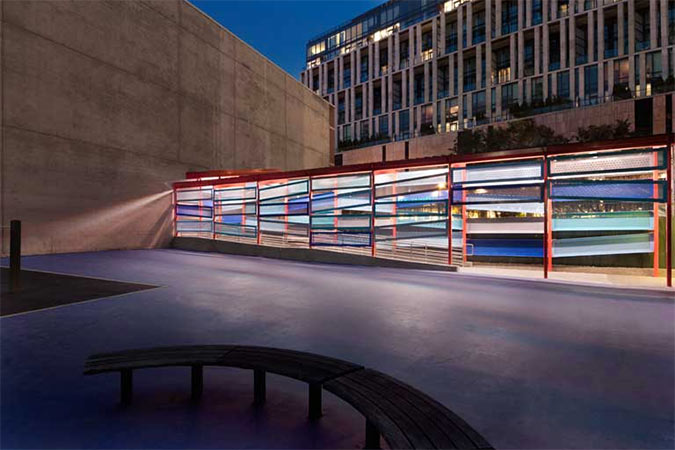
It is a sad state of affairs, but often a fact, that many New York architecture practices take public work only as a sideshow to more fashionable and profitable residential and corporate projects. This model of practice is not one that Macrae-Gibson Architects has followed since its was founded in 1982. In fact, though the firm has a healthy number of residential and commercial projects—from upper east historic district townhouses to social housing in Newark—it is their public or institutional projects they proudly claim have become imbedded in the texture of the city, quietly strengthening its architectural quality.
These public projects often, but not always, work with the idiom of New York’s New Deal–inspired institutional vocabulary that, though we too often take it for granted, is a high moment in public design in this country. For example, the firm’s clean restoration and addition to PS 170 in Bay Ridge, Brooklyn, smartly follows the school’s existing New Deal design (focusing on making it more environmentally sustainable) but also borrows from the large window tradition of New York factories. The project fits naturally and heroically (it opens in fall 2015) into the residential context of the neighborhood. The firm’s ability to work in this public tradition can be seen in their ground-up, 75,000-square-foot, through-block design for PS 313 in Sunnyside, Queens. It continues this tradition, but elevates the surrounding context with its patterned and striated colored bands of brick, stone, and large glass openings. They also strove to bring light into the interior spine of the structure’s 12-foot-high floors with a large skylight. The building has the only-in-New-York design component of a roof top play yard with its steel mesh protective wall.
But this is not to say that Macrae-Gibson Architects cannot also do clean, beautifully conceived and detailed modernism in their institutional work. At Truman High School in the central Bronx the firm beautifully restored the school’s 75-foot, 6-lane swimming pool, bleachers, and changing room. And in adding a new extension to PS 234 in Manhattan, the firm created a covered walkway with bright primary colors. The walkway was meant to create a strong visual connecting link with the three-story extension that is a good distance away from the “mother” school building.
This is a firm that has a diverse portfolio of residential and commercial work, but it is important to recognize its desire—expressed by its founder, Gavin Macrae-Gibson—to not always follow fashion, but rather work within an honorable and important tradition of public architecture.
PS 313
Queens, New York
A new ground-up building, PS 313 opened this month in Sunnyside, Queens, confirming the firm’s research into the historic typology of New York school architecture. The building’s design falls in this idiom, last updated in the 1930s with New Deal federal assistance, but moves it forward in a popular way that ‘fits’ into the Sunnyside streetscape, elevating the architecture of the historic neighborhood. The through-block building is brick faced with large window openings and brings light into the interior public space with a large skylight. It also creates a landmark in the area with a tower and clock.
Truman High School
Bronx, New York
It is hard to imagine how dreary this high school swimming pool was before this colorful and imaginative restoration. The firm’s use of strong and often contrasting color is a major part of many of its projects. The pool area is a double height space that has slim strips of blue mirror set into the glazed walls that reflect light and water, providing a horizontal emphasis accentuating the surface of the pool. Further, two handicap-accessible viewing platforms are emphasized with bright blue mosaics. Colorful bands around the pool itself make the white walls and coffered ceiling seem even more pristinely white.
PS 234 Walkway
New York, New York
This colorful walkway connects PS 234 on Greenwich Street in Tribeca with its annex half a half block away. The brick and stone postmodern architecture of the 1988 building is supposed to be taken from the “day dreams of kids,” according to the AIA guide book to New York City, but its brick wall is dull and instantly forgettable. Further, the annex is located in the dreariest tower block in the area, so this colorful covered walkway not only connects the two structures, it enlivens the entire street scape and provides a joyful wall and space for the grammar school children. The playful color palate seems as fresh today as when it was built in 2010.
110-120 East 76th Street
New York, New York
The firm is restoring the facades of six Upper eastside townhouses, which were designed in the Neo-Grec style by Augustus Hatfield in 1883. The restoration of the facades includes new entrances appropriate to the scale of the residences, new front yards, fences, steps, and a new one-story penthouse addition on the roof setback, which is not visible from the street. The interiors of the townhouses are completely new, as are the rear facades, which refer to the memory of the original architecture. The townhouses are distinguished from each other by varying amenities and overall style of the interior design.